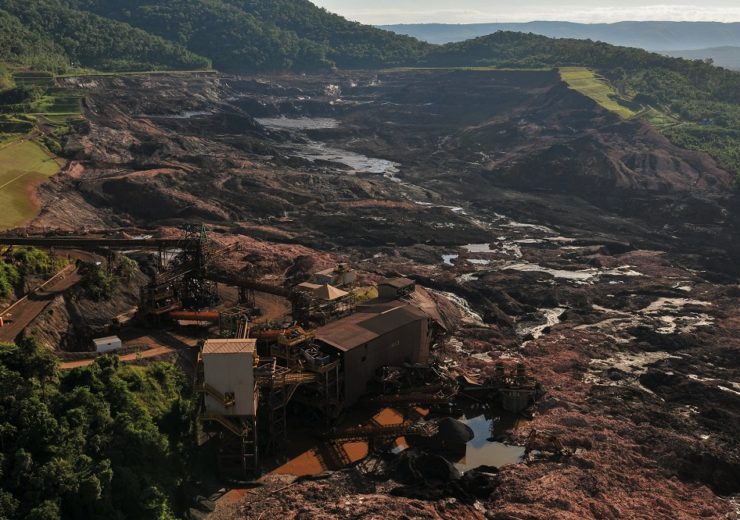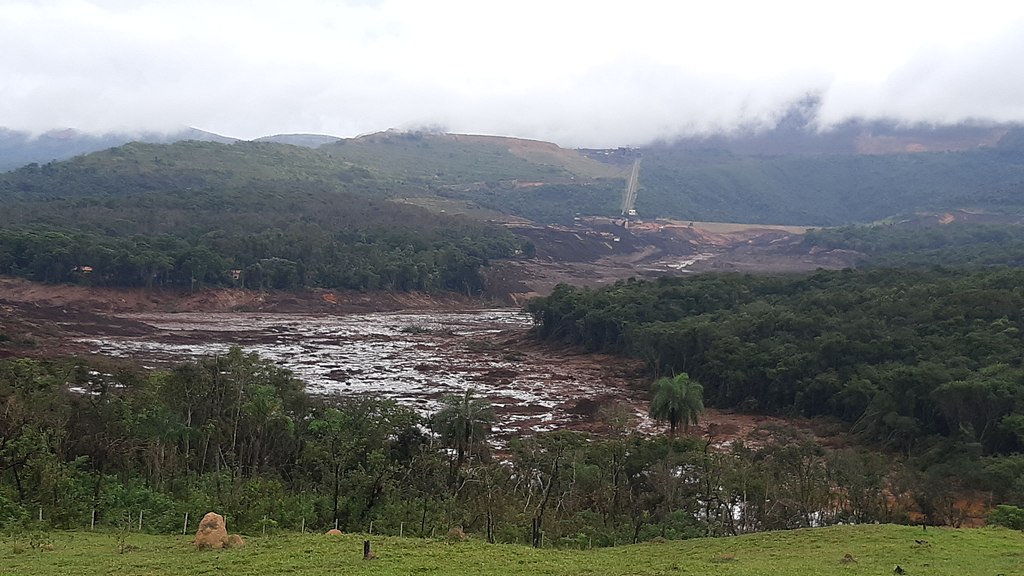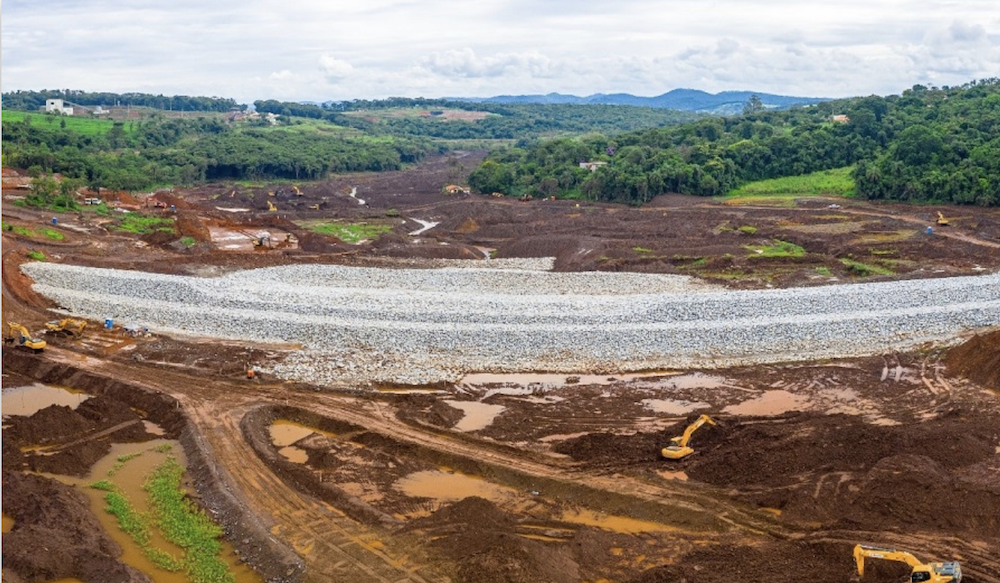An insight into the findings of the expert panel’s technical report on the Brumadinho tailings dam failure in Brazil.

The aftermath of the Brumadinho tailings dam incident (Credit: Flickr/Ibama)
The panel of geotechnical experts hired to investigate Brumadinho tailings dam failure in Brazil was faced with the challenge of determining what triggered the failure when the dam had not shown any signs of distress prior to the tragic incident.
On 25 January 2019, an iron ore tailings dam at Vale SA’s Córrego do Feijão mine near Brumadinho, in Brazil, suffered a sudden and catastrophic failure.
The initial visible failure began at the crest and continued down to an area above the starter dam. It extended throughout much of the face of the dam, and was over in 10 seconds.
Nearly 10Mm3 of tailings were released in less than five minutes and mudflow from the structure travelled rapidly downstream, killing almost 250 people.
The failure is described as being unique for two reasons:
- High quality video images of the incident have provided an insight into the failure mechanism.
- There were no apparent signs of distress before the failure. Footage from drones flown over the dam seven days earlier did not highlight any problems, while extensive monitoring from various instrumentation installed on the dam did not detect any signification deformations of changes prior to the event.
Expert panel convened to investigate the failure
An expert panel was commissioned by Vale to investigate and determine the technical causes of failure.
Dr Peter Robertson, a retired professor of geotechnical engineering with more than 35 years of experience, chaired a panel of geotechnical experts:
- Lucas De Melo has over 20 years of experience in geotechnical aspects of dams and engineering projects in Brazil and the US, having previously participated in numerous safety studies and forensic analysis of dam incidents.
- David Williams initiated and directs the industry funded Geotechnical Engineering Centre at the University of Queensland in Australia and has over 40 years of teaching, research and consulting experience.
- G Ward Wilson has more than 35 years of industrial experience in advanced mine waste management and has served as a specialist review consultant for many international mining projects.
“We used our professional judgement and expertise in conducting our investigation and in reaching our conclusions,” Robertson said. “I want to say that all of us serving on the expert panel fully appreciate the important responsibility that we have undertaken.”
No panel member had previously worked for Vale or on any matter relating to the failed dam. They relied on assistance from consultants to review historical data, evaluate specific subject areas, conduct field and laboratory testing, and carry out computer modelling.
Consultants that were involved included: Geosyntec Consultants; Klohn Crippen Berger; and Bentley Systems (formerly known as SoilVision).

Ten month investigation into the Brumadinho tailings dam failure
The panel began its investigation in March 2019 and completed its work in December 2019.
Panel members visited the dam in March and June 2019 to observe its features, while in July 2019 an extensive field-testing programme was carried out.
They also reviewed documents, data, and information obtained from Vale and other third parties, including:
- Video footage of the dam on the day of the failure.
- Documents reflecting the design and construction history of the dam.
- Records relating to activities at the dam.
- Analyses, reports, and presentations regarding the dam.
- Data from instrumentation and monitoring devices installed at the dam.
- Satellite, light detection and ranging laser, and interferometric synthetic aperture radar data.
- Drone footage and photographs of the dam.
- Data from seismic monitoring devices at or near the dam.
The final report was released in December 2019. A dedicated website was established to ensure that the technical document could be shared, along with its various appendices and video presentations.
Breaking down the report
Divided into ten sections, the report:
- Describes the failure and its impacts.
- Explains the panel’s methodology in conducting the investigations.
- Discusses the dam history.
- Presents the analysis of pre-failure deformations.
- Summarises the analyses of water movement within the dam over time.
- Presents stability and deformation analyses
- Summarises the panel’s conclusions.
“In doing our work,” Robertson says, “the expert panel had access to an enormous quantity of data about the dam — including full, clear videos of the dam collapse. That wealth of information has allowed us to reach certain conclusions. But I caution that we are engineers, trained to understand and explain how things work — not experts on corporate and risk management.
“For that reason, our mission was limited to determining the technical causes of this failure. Others will address the question of any responsibility as well as make recommendations to prevent such tragedies in the future.”
Technical causes of the Brumadinho tailings dam failure
In summary, the expert panel explained that the dam failed when the tailings experienced a sudden and rapid strength loss (flow or static liquefaction). The dam was essentially too steep and too wet, and the material in the dam was loose, saturated, and very heavy and brittle.
The failure was also due to internal creep strains that when combined with a small reduction in strength in areas of the dam due to infiltration from accumulated heavy rainfall, caused flow liquefaction to occur.
In their assessment of the technical causes of the dam failure, the panel said they had to start with an understanding of “what this dam was”. Such a tailings dam “should be designed and constructed to be sufficiently permeable to allow drainage of water out from behind the dam, particularly because the stored tailings contain a lot of water that must be allowed to drain, or in other words, allowed to slowly flow or migrate out from behind the dam”.
However, a cross-section of the Brumadinho dam showed high-water levels. The absence of proper drainage created a higher water level that reduces the ability of the material to resist load.
“This can undermine the stability of the dam,” Robertson stated. “In short, water is the enemy in a tailings dam like this.”
Design and construction of the Brumadinho tailings dam
The panel says that the dam’s construction history provide insight into the possible reasons for the failure. Construction started in 1976 and the structure was subsequently heightened — or “raised” — several times by adding new layers on top of old ones.
The tenth and last raise took pace in 2013, with each raise using the upstream method of construction.
“The design and construction of the dam is a contributing factor to its failure,” the report stated.
As Robertson and his colleagues discuss, the original dam design and construction, carried out by Ferteco (a mining company acquired by Vale in 2001), did not allow for proper drainage.
The starter dam itself was constructed to be essentially impermeable, retaining water instead of allowing it to drain. The starter dam and the other raises combined with layers of fine tailings had low permeability, resulting in the water level being close to the surface at the toe of the dam.
In addition, Robertson says, the dam was located where a lot of water flowed into the retention area due to runoff from the surrounding area, underground springs, and seasonal heavy rains.
Another flaw in the dam’s original design was that its slope was very steep. When a dam has a steep slope, greater stress is placed on the material in the dam. After the third raising, Robertson said that a setback was constructed to reduce the overall slope but it still remained quite steep.
“Hence, maintaining the stability of the dam was a continuing challenge over the life of the dam because its original design and construction was not robust: essentially,” Robertson states, “it was too wet and too steep.”
However, in the months before the collapse of the dam, it was not showing any signs of distress or approaching failure.
In addition, tailings had not been deposited in the dam for over two years and efforts to reduce water levels were slowly succeeding. There was no cracking, horizontal deformations or excessive seepage in the days before the event.
“The challenge for the panel was to determine what caused the sudden strength loss that resulted in flow liquefaction to occur when it did. In other words,” Robertson asked, “what was the trigger that caused the dam to fail? “
Different tailings material used at the dam
The panel was surprised to learn that the tailings in the dam had a very high iron content (more than 50%) and a very low quartz content.
“This material was quite different from the tailings material of many other tailings dams that have been studied. It also was very different from the natural soils that exist in the many case histories used to guide most designs. We also were surprised to find evidence of bonding between the tailings particles because of iron oxide,” Robertson said.
The panel explained that this sort of material is extremely brittle and when bonded in this way has a high peak strength, meaning it can withstand higher stresses than would normally be expected for tailings that have little or no strength loss.
But when such bonded material is subjected to forces or stresses over time, it can at some point suddenly lose most of its strength under undrained conditions.
“Importantly,” Robertson added, “materials of the sort found in this dam can experience high “internal creep” rates when subjected to shear stresses like those that were present in this dam being too steep and too wet.”
The process of internal creep
Internal creep is described as being a constant but slow process. When a material is susceptible to internal creep it is initially stiff and strong, but vulnerable to very slow deformation.
Significantly, the bonding of the tailings due to iron oxide had the effect of making the dam appear to be stronger and more robust than it actually was – without the normal signs of distress or imminent failure.
Furthermore, the internal creep movements were so small that they would not show signs of distress on the surface or be a predictor of failure.
“To summarise,” Robertson says, “the bonding of the tailings because of iron oxide created a stiffer, more brittle material that only required a relatively small strain to trigger strength loss and failure. The stresses in the dam caused by the dam being too wet and too steep were sufficient to cause ongoing creep strains.
“The evidence shows that the failure on 25 January 2019 was caused by a combination of ongoing creep strains and a small strength reduction due to loss of suction from accumulated heavy rainfall, including the intense rainfall toward the end of 2018.
“This was confirmed by advanced laboratory testing and computer simulations. These findings are not something that we have seen before in connection with other tailings dam failures,” Robertson added.
Possible triggers of the failure
The panel’s investigation also focused on possible triggers for a sudden and rapid strength loss capable of causing the tailings dam failure.
It was recognised that the triggers could be relatively small, given the high shear stresses and brittle nature of the tailings within the dam prior to failure, and that they could be due to the cumulative effect of multiple small events.
No earthquakes were recorded in the region on the day of the failure and all other potential triggers were ruled out based on the available evidence. Robertson was keen to discuss three events which had been mentioned as being possible triggers or causes:
- Blasting in the open pit mine at the site has been raised as a possible trigger of the failure. However, analysis of seismograph data showed that the blast that occurred closest to the dam on the day of the failure did not occur until after the dam had failed.
- Drilling of a vertical borehole, part of a project to test soil and install more monitoring devices, was underway at the dam on the day of the collapse. These were very small and computer simulations confirmed that they would have only had a small, localised impact on the dam and were not triggers.
- Beginning early in 2018, deep horizontal drains or DHPs were installed in the dam to reduce water levels. When DHP number 15 was being installed in June 2018, it caused a flow of turbid muddy water to seep out of the dam for several days. This incident did not cause the dam to fail at the time and computer simulations show that it did not cause the dam to fail seven months later. The simulations demonstrated that the incident likely caused a localised hydraulic fracture that was insufficient to trigger global instability in the dam. The panel says it believes that this event did not create a condition in the dam that persisted at the time of the failure.

Fast facts on the causes of the tailings dam failures
Experience has shown that tailings dam failures are rarely due to one cause. The expert panel investigating Feijão Tailings Dam failure says that the following history created the conditions for instability in the dam:
- A design that resulted in a steep upstream constructed slope.
- Water management within the tailings impoundment that at times allowed water to get close to the dam crest, resulting in the deposition of weak tailings near the crest.
- A setback in the design that pushed the upper portions of the slope over weaker fine tailings.
- A lack of significant internal drainage that resulted in a high water level in the dam, particularly in the toe region.
- High iron content, resulting in heavy tailings with bonding between particles. This bonding created stiff tailings that were potentially very brittle if triggered to become undrained.
- High and intense regional wet season rainfall that can result in a loss of suction, producing a small loss of strength in the unsaturated materials above the water level.
